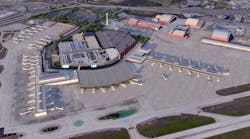RENO - TSA chief technology officer Chuck Burke, speaking with a quiet confidence about the state of the security agency, told airport consultants gathered here that the agency has sent its revised strategic plan to Congress for consideration and that the future implementation of security systems at U.S. airports relies heavily on close cooperation between airports and TSA. Burke was here to address the annual Airport Planning, Design, & Construction Symposium, which annually brings some 600 consultants, airports, and government officials together.
According to Burke, 18 U.S. airports have fully integrated in-line explosives detection systems in place, while another 36 are "partially integrated." Says Burke, "We continue to support the efforts of airports to put in-line systems in place." Key to the effort, he advises, is to get TSA heavily involved early in the installation process, particularly important so that the agency can advise airports on how the technology they are considering may remain useful over the long term. That said, he also advises that new systems are under development in the laboratory which will be able to accommodate some 1,000 bags per hour with accuracy rates exceeding 90 percent.
Also speaking at the symposium was Dr. Randy Null, who heads up TSA's technical division in coordination with the Department of Homeland Security. He, too, gives the sense that the agency is becoming one that has a true handle on the situation at U.S. airports and the issues they face.
Of course, the answer of who will fund all of these systems which still need to be installed remains unanswered by Congress. The legislature remains unwilling to fund what it has mandated. Airports, it seems, remain on their own regarding that aspect of the discussion.
Thanks for reading.



